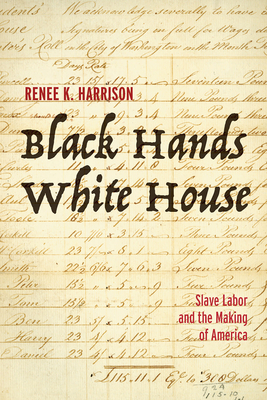Book Review: Black Hands White House: Slave Labor and the Making of America
by Renee K. Harrison
Publication Date: Nov 02, 2021
List Price: $28.00
Format: Hardcover, 380 pages
Classification: Nonfiction
ISBN13: 9781506474670
Imprint: Fortress Press
Publisher: 1517 Media
Parent Company: Evangelical Lutheran Church in America
Read a Description of Black Hands White House: Slave Labor and the Making of America
Book Reviewed by Robert Fleming
Renee K. Harrison, an associate professor of African American and US religious history at Howard University, digs deep into the cultural and financial benefits of enslaved labor during the peak of slavery. Her book, Black Hands White House: Slave Labor and the Making of America, examines the significant role of this work force in making American and European economic giants rich.
In her introduction, Harrison explains why the themes of the book favored the resilient slaves at odds with the monetary might of the slave-based economies. “My vocational passion is grounded in history. I am driven by a deep yearning to connect with Black people, devalued, and long forgotten during and since American slavery. I am drawn to communing with them, hearing their stories, and learning more about them- their contributions, spiritual strivings, rituals, and rhythms, wit and wisdom, and how they negotiated spaces of white terror and whiteness.”
Written with heartbreaking realism, often poignant and wry, but always exhilarating, the author uses a treasure trove of facts and observations to link the major commodities such as sugar, cotton, rice, and tobacco to the wealth of Founding Fathers and the greedy European immigrants and their bloodline. What is most informative in the book is the detailed list about the major institutions and companies benefiting from American slavery and enslaved labor, such as Bank of America, Aetna, Brown University, Columbia University, Clemson University, Harvard University, Jack Daniels, Georgetown University, the Jesuits, Lehman Brothers, Presbyterian Church, Rutgers University, Union Pacific, Tiffany & Co, USA Today, and University of Pennsylvania.
Other than construction and agriculture, the colonists discovered the many areas of work that served the economy. Black people toiled as cooks, maids, domestics, seamstresses, midwives, nannies, launderers, butlers, bakers, tailors, and waiters. These men and women acted as the glue that kept the American colonist society going.
The Founding Fathers, who owned slaves, saw the practice of breeding to increasing the workforce and producing more crops. Although the colonists touted “unalienable and God-endowed rights” mentioned in the Declaration of Independence, they were breeding Blacks and writing laws that keep the slaves in bondage. The white men shut their eyes and consciences to the evils of slavery and enslaved labor when those things enabled them to live a life of comfort and leisure.
Harrison asked the crucial questions going to the heart of the matter: “But why would the framers include Black people in their “unalienable God-endowed rights” clause? Why would they grant them “life, liberty, and the pursuit of happiness”? They gaze on Black-bodied people was affixed not o Black peoples’ humanity but rather ton their utility value. Thus they made a calculated decision to see black people first and foremost as property, not people and chattel, not individuals with destinies and dreams.”
The author put two of the Founding Fathers, George Washington and Thomas Jefferson under the microscope, revealing not just the public image but the inner workings of their estate, Mt. Vernon and Monticello. Both men used enslaved labor to build their mansions. Both men were also innovative and very competitive in their business dealings. Washington inherited 11 slaves in 1743 from his great-grandfather but that total increased to more than 315 during his lifetime. The average price of Blacks ranged $200 to $425 in the glory days of the colony.
One of the enlightening segments is the use of enslaved workers in the Capital City (Washington D.C.), employed to not only to build the White House but they contributed to the grandeur of U.S. Capitol, the National Mall, the US Treasury, the US Supreme Court, and the Library of Congress. Whites were hired as master brick makers, while enslaved and free blacks did the dirty and dangerous work, digging clay from a local river, maxing it with water and sand, molding it into fired bricks. Enslaved laborer earned $4 to $5 from the bottom pay scale or $60 yearly salary.
With the sacrifice, time, and energy endured by enslaved workers in our nation’s capital and throughout our land, Harrison proposed a grand memorial celebrating their blood, sweat and bondage. In the book, she explained this way: “A monument’s power rests not in its ability to shy away from truths but in honoring the full scope of a more nuanced depiction of an individual, group, and historical moment.” This is an idea whose time has come.
Many monuments have taken off from their pedestals due to racist themes. Even now, there are hundreds of petitions to remove these tarnished statues. For example, many sites exist on Southern soils, embracing the prejudiced traditions of confederate spirit, and the legal fight continues.
“America is one piece of the more extensive network that traumatically altered Black-bodied people’s s destinies and dreams,” Harrison writes. “America must accept its blighted and destructive past. Only in doing so will its history be accurately reflected in its monuments and memory.”
Harrison’s book serves up a forgotten chapter of our history, with more facts that some want definitely to erase. It offers an exceptional, vivid account of Black sweat and sacrifice that cries out as more testimony in the reparations matter. This should be required reading for our young minds wishing to learn about our history.

